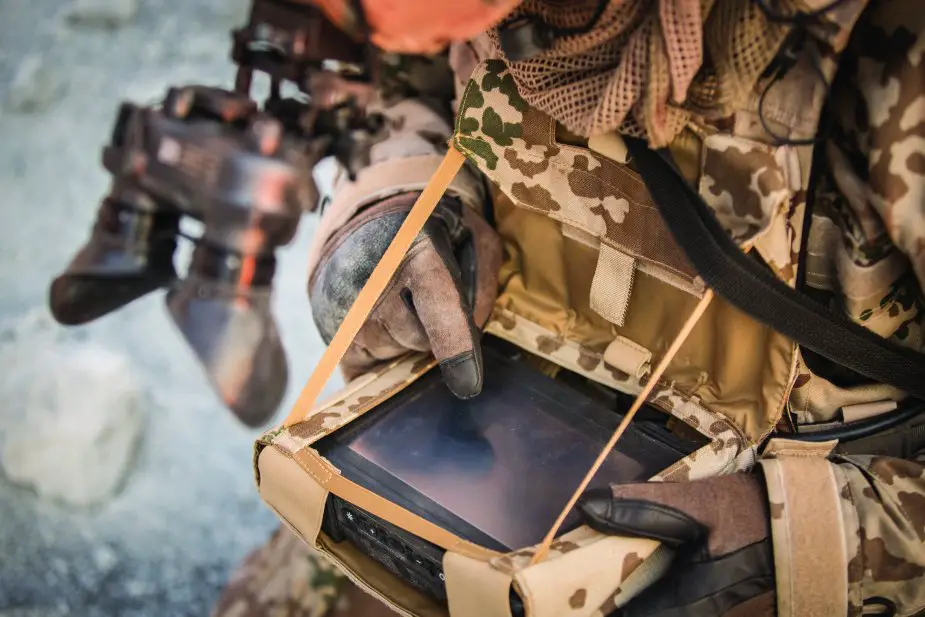One of the first tasks of commanders will always be to grasp the battlefield. A vital prerequisite for this is a common operational picture, an essential basis for successful network-enabled operations. At DSEI 2017, Rheinmetall is showcasing its wide-ranging expertise in this field.

Rheinmetall & Rohde & Schwarz are jointly bidding for the Bundeswehr MoTaKo requirement
(Credit: Rheinmetall)
As a systems supplier, Rheinmetall specializes in incorporating soldiers, sensors, effectors, drones and tactical vehicles into highly effective “systems of systems”. Rheinmetall also cooperates with industrial partners in this field of activities.
In a joint venture with Rohde & Schwarz, Rheinmetall is competing as general contractor for two major Bundeswehr projects: MoTaKo (German military shorthand for “Mobile Taktische Kommunikation” or mobile tactical communication), and MoTIV, which stands for “Mobiler Taktischer Informationsverbund”, or mobile tactical information network. The two projects will culminate in the German Army’s future digital combat command system – “German Army 4.0”, as it were.
At Rheinmetall’s Stand S7-110, a MoTaKo/MoTIV command post brings additional troops, vehicles and components into the command-and-control loop via a mobile communication node, creating a common operational picture in a tactical scenario. Among others things, the items on display include:
* TacNet command system: The TacNet command system forms the nerve centre of networked systems. Flexible inclusion of additional troops, sensors, effectors or platforms is possible at all times.
* Soldier systems: Rheinmetall possesses comprehensive expertise in the world of soldier systems. Prominent examples are “Infanterist der Zukunft – Erweitertes System” (IdZ-ES; infantryman of the future – extended system) which is operational in the German Army as well as Argus which is under procurement by the Canadian Armed forces. The new soldier system Gladius 2.0 is debuting at this year’s DSEI.
* RS556 assault rifle: The 5.56mm x 45 cal. modular multipurpose RS556* rifle is designed for maximum reliability and ease of use. It can also be equipped with an optional 40mm build-on RS40* grenade launcher.
* PanoView: Likewise on display at DSEI is “PanoView”, another example of Rheinmetall’s approach to network-enabled warfare. This innovative system features sensors mounted on the outside of an armoured vehicle which transmit real-time images to goggles worn by the vehicle commander. In effect, the commander can see right through the armour, drastically improving situational awareness. Moreover, the system imports tactical situation data, e.g. marking the location of friendly and enemy elements on the ground. In addition, PanoView can be used to process virtual situation maps.
* Multi Mission Unmanned Ground Vehicle (MM UGV): Deployed in conjunction with infantry components, unmanned systems enable rapid reconnaissance and engagement. Rheinmetall’s Multi Mission Unmanned Ground Vehicle features a modular design. This enables integration of different mission kits for a wide variety of different operational tasks: it can be configured as transport vehicle, a sensor platform for surveillance and monitoring, for example, or as a weapon carrier. Remote control and autonomous operation are both possible.
* Vehicle Systems: Rheinmetall also adds the infantry group’s main weapons systems to the network, e.g. the Puma* infantry fighting vehicle and the Boxer* 8x8 wheeled armoured vehicle, configured for a combat role with the two-man LANCE turret.
Rheinmetall can also add other components to the network and offer flexible solutions tailored to the mission.














